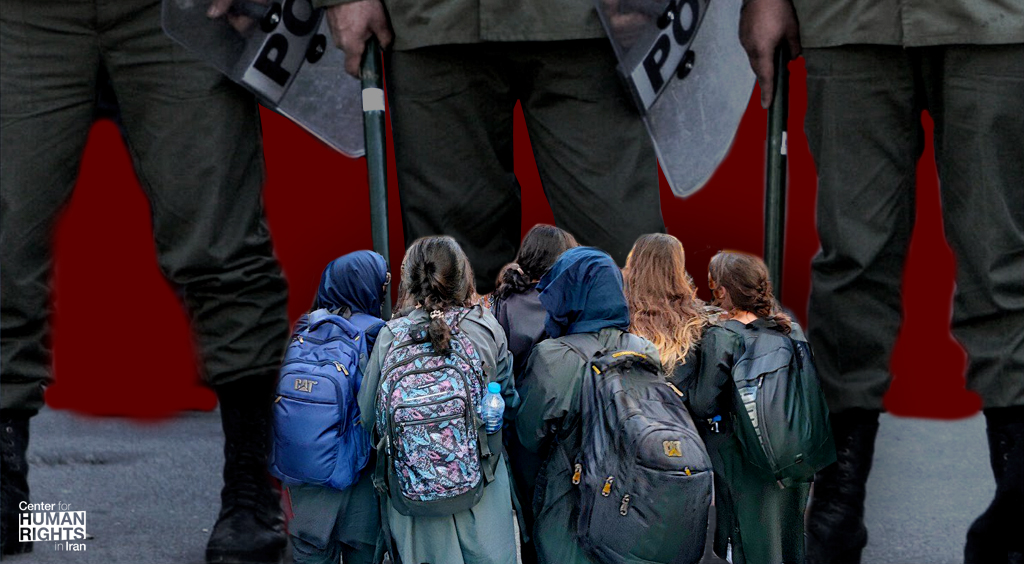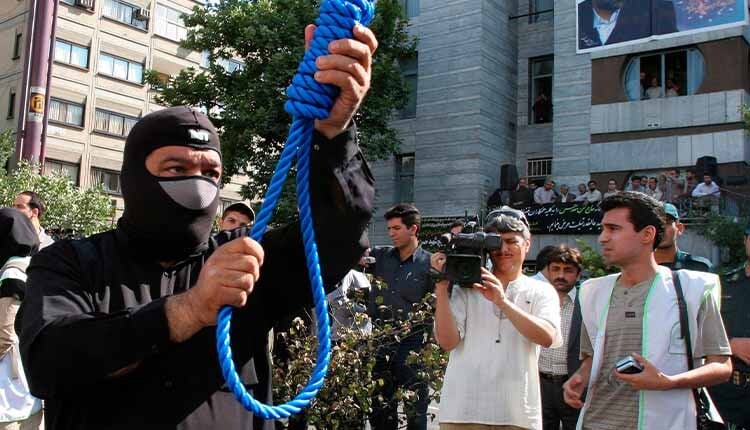 Officials Paint Children as Enemies of the State, Claim They’re “Reforming” Kids
Officials Paint Children as Enemies of the State, Claim They’re “Reforming” Kids
At Least 28 Children Killed Since September 16, Reports Tehran-based Group
October 13, 2022 – The arrests and interrogations of school children accused of joining nationwide protests in Iran and their detention in so-called “psychological centers” has raised fears of more child killings in the fourth week of protests that have been spreading across the country since September 16.
“Call this what it is: Kidnappings of children by a state that is stopping at nothing in its attempts to quell protests and terrify the people of Iran into submission,” said Hadi Ghaemi, executive director of the Center for Human Rights in Iran (CHRI).
“UNICEF, which has an office in Iran, should be tracking down these defenseless children and getting them back to their families,” said Ghaemi. “World governments should loudly call on Iranian officials to stop arbitrarily detaining children as well as adults for exercising their right to protest, as well as urge for the end of lethal force against protesters.”
“U.S. President Joe Biden and democratic allies at the UN should establish an urgent special session at the UN Human Rights Council to bring governments into a debate over the current violent crackdown and Iran’s ongoing human rights crisis,” he added.
At least 28 children are among the reported minimum number of 201 individuals killed since anti-state, nationwide protests erupted in the country in mid-September after the death of Mahsa Amini, 22, following her arrest by the morality police.
The number of 28 children was reported by the Tehran-based Association for the Protection of Children on October 10, which added that “the largest number” of deaths occurred in the province of Sistan and Baluchistan.”
On October 11, 2022, Education Minister Yousef Nouri told the Shargh daily that an unspecified number of children had been sent to reeducation camps after they were arrested allegedly for engaging in anti-state protests.
“We do not have students in prisons and those who have been detained are in psychological centers for discussions on reforming and educating them. Our expert friends are in charge of this, so the students can be returned to their schools,” Nouri said.
Reza Hadjipour, MP and spokesperson for the Education Committee of the parliament in an interview with Rokna news agency confirmed high school students are being detained but downplayed it by saying: “There are few students in detention, mainly those who are in contact with opposition networks abroad. Our friends have summoned them and are interrogating them now.”
The comments have caused fury in Iran, especially at school teachers and principals who’ve been accused of aiding intelligence and security agencies in detaining the kids.
“For the last time we warn high school principals in the city of Karaj to stop making schools security zones and not to continue sharing video footage from school cameras with security and intelligence agents,” said a statement by the Organization of Associations of Teachers on October 13.
“We have received names of those teachers and principals in schools, we will not publicize them for now,” added the statement. “We ask you to wake up and stop contributing to the bloodshed. Otherwise, we will publicize the names and pictures of these so-called teachers and principals.”
Iranian officials have not specified how many children have been arrested and have cut internet and phone access to the country to prevent information from reaching the outside world.
Information posted on social media indicates that children have been arrested in at least three cities: Karaj, Bandar Abbas, and Sanandaj, where Iranian authorities have been waging a lethal crackdown on protests there.
“Iranian officials operate with such impunity that they openly admit to child kidnappings without any fear of being held accountable for engaging in such monstrous actions,” said Ghaemi.
“We can’t look at the signing of a nuclear deal with Iran in isolation; efforts at nuclear nonproliferation are important, but what will flow from this specific deal is a significant release of funds that will only serve to increase the repressive capacity of the regime,” he added.
“Empowering the Islamic Republic by bolstering its economic capacity at a time when it is violently and unlawfully trying to crush peaceful public protest and dissent, including by arresting kids, is an effective interference in the country’s domestic affairs—it actively assists the government,” said Ghaemi.
Iran Protests: The Significance of Oil Workers’ Strike

On Monday, workers at a petrochemical complex in Asaluyeh, southern Iran, went on strike. Their colleagues in the Abadan oil refinery also joined them on Tuesday. Four weeks into the major Iran protests, the oil and petrochemical workers’ strike is considered a turning point.
This is not the first time oil workers, mainly contract oil workers, have gone on strike. But previously, they staged protests and demanded their rights. Their demonstrations were quashed, and many deprived workers were arrested or laid off. Yet, Iranian oil workers joined the nationwide uprising and popular “regime change” demand.
Initially sparked due to the death of a 22-years-old Kurdish girl in police custody, Iran protests have now morphed into a revolution, with people demanding nothing less than regime change. Protests have persisted despite the regime’s heavy crackdown.
The first turning point of Iran’s uprising was Saturday’s protests, with students joining them. These protests happened a few days after the bloody crackdown on innocent prayers in Zahedan and after the regime’s supreme leader Ali Khamenei threatened Iranians while praising his oppressive forces.
Iran’s uprising experienced what many consider its second turning point when the contract oil workers began their strike for several reasons:
- Considered the regime’s main source of income, the oil industry’s shutdown or partial shutdown delivers a major blow to Iran’s ruling theocracy. In other words, workers control the regime’s most important economic lifeline.
- Iran’s workers are among the most oppressed and underprivileged sectors of society. The regime’s corruption and ineptitude have turned Iran’s society, and particularly the workers’ community, into a powder keg. Iran has nearly 15 million workers, who form a large part of the population with their families. Thus, workers joining the uprising seriously threaten the ruling theocracy.
- These workers have nothing to lose due to the regime’s corruption and plunder of their wealth. Their participation in the current uprising means protests have entered a new era.
- Iranian oil workers have their unions and are among the most organized sectors due to their history of defiance. Thus, they could more easily organize protests and strike, and the rapid spread of strikes is a testament to this fact.
- It is worth noting that during the last months of the Shah’s regime, the Iranian oil workers’ strike in 1979 delivered an irreparable blow to the regime. The international community did not sanction the Shah’s regime, yet the workers’ strike seriously damaged its economy.
In a nutshell, the strike by contract oil workers reaffirmed the Iranian people’s unwavering resolve to overthrow the ruling theocracy at any cost. The regime plunders the Iranian nation’s wealth to prolong its rule through the export of terrorism abroad and domestic oppression. The world community should increase its pressure on the regime and help Iranians achieve their rights.
World Day Against Death Penalty and Iranian Protesters’ Plight

October 10 marked the World Day Against the Death Penalty while the world’s top executioner per capita, Iran, witnessed anti-regime protests for the fourth consecutive week.
Since taking power in 1979, Iran’s ruling theocracy has been using executions to intimidate the vibrant and progressive society that has rejected mullahs’ backward thinking from day one. The regime’s incessant use of capital punishment has earned it the first rank of executioner per capita. Hundreds of Iranians are sent to the gallows every year under different pretexts, mainly political dissidence.
The clerical regime never stopped executions during Hassan Rouhani’s presidency, who presented himself as a “moderate,” roughly 5,000 Iranians, including over 130 women, were hanged.
Since Ebrahim Raisi took over for Rouhani in 2021, there have been nearly 800 executions. The number should be more, given the regime’s secrecy in announcing executions. In other words, executions have seen a dramatic since Raisi became president.
This was no surprise to human rights defenders and the Iranian people, as Raisi’s dark record of human rights violations was common knowledge. In fact, the regime Supreme Leader Ali Khamenei pulled him out of the ballot box in a bid to use him as the bogeyman to terrorize Iran’s restive society.
Raisi played a key role during the mass political executions in the 1980s. During the 1988 massacre of over 30,000 political prisoners across Iran, Raisi sat on Tehran’s so-called “Death Commission,” sealing the fate of tens of thousands of prisoners. Based on a fatwa by the regime’s then-supreme leader Ruhollah Khomeini, those commissions were tasked to identify and purge political dissidents, mainly supporters and members of Iran’s leading opposition group, the People’s Mojahedin Organization of Iran (PMOI/MEK).
The 1988 massacre remained uninvestigated and unpunished, perpetuating what many observers believe is the “culture of impunity.” When Raisi became the regime’s president in 2021, Amnesty International’s Secretary General Agnès Callamard referred to this development as a “grim reminder that impunity reigns supreme in Iran.”
This impunity once again showed its evil face during the regime’s heavy crackdown on protesters throughout the last four weeks. The regime’s security forces are opening fire on protesters, and according to the reports tallied by the MEK, over 400 people have been murdered in cold blood during the recent onslaughts.
Besides, roughly 20,000 protesters have been detained, many facing the risk of being executed. Mostafa Salehi and the wrestling champion Navid Afkari were detained during the 2018 major protests and were hanged, despite an international outcry to save their lives.
It is crystal clear that Iran’s ruling theocracy, like any other dictatorship founded on human rights abuses, will never end its violence. These regimes know that without full-fledged oppression, including executions, they wouldn’t last a day.
Therefore, it would be a mirage to believe in an end to the violence employed by Iran’s clerical. The world community should end the naive thinking that dialogue would impact the regime’s cycle of violence. The only way to break this cycle is to recognize the right of all Iranians to self-defense against this brutal regime. The time has come for the international community to go beyond condemnations and take concrete actions to end the crisis of impunity in Iran.

 Officials Paint Children as Enemies of the State, Claim They’re “Reforming” Kids
Officials Paint Children as Enemies of the State, Claim They’re “Reforming” Kids

No comments:
Post a Comment